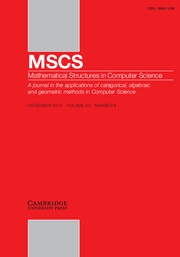No CrossRef data available.
Article contents
T0-spaces and the lower topology
Published online by Cambridge University Press: 19 September 2024
Abstract
The authors’ primary goal in this paper is to enhance the study of  $T_0$ topological spaces by using the order of specialization of a
$T_0$ topological spaces by using the order of specialization of a  $T_0$-space to introduce the lower topology (with a subbasis of closed sets
$T_0$-space to introduce the lower topology (with a subbasis of closed sets  $\mathord{\uparrow } x$) and studying the interaction of the original topology and the lower topology. Using the lower topology, one can define and study new properties of the original space that provide deeper insight into its structure. One focus of study is the property R, which asserts that if the intersection of a family of finitely generated sets
$\mathord{\uparrow } x$) and studying the interaction of the original topology and the lower topology. Using the lower topology, one can define and study new properties of the original space that provide deeper insight into its structure. One focus of study is the property R, which asserts that if the intersection of a family of finitely generated sets  $\mathord{\uparrow } F$,
$\mathord{\uparrow } F$,  $F$ finite, is contained in an open set
$F$ finite, is contained in an open set  $U$, then the same is true for finitely many of the family. We first show that property R is equivalent to several other interesting properties, for example, the property that all closed subsets of the original space are compact in the lower topology. We then find conditions under which these spaces are compact, well-filtered, and coherent, a weaker variant of stably compact spaces. We also investigate what have been called strong
$U$, then the same is true for finitely many of the family. We first show that property R is equivalent to several other interesting properties, for example, the property that all closed subsets of the original space are compact in the lower topology. We then find conditions under which these spaces are compact, well-filtered, and coherent, a weaker variant of stably compact spaces. We also investigate what have been called strong  $d$-spaces, develop some of their basic properties, and make connections with the earlier considerations involving spaces satisfying property R. Two key results we obtain are that if a dcpo
$d$-spaces, develop some of their basic properties, and make connections with the earlier considerations involving spaces satisfying property R. Two key results we obtain are that if a dcpo  $P$ with the Scott topology is a strong
$P$ with the Scott topology is a strong  $d$-space, then it is well-filtered, and if additionally the Scott topology of the product
$d$-space, then it is well-filtered, and if additionally the Scott topology of the product  $P\times P$ is the product of the Scott topologies of the factors, then the Scott space of
$P\times P$ is the product of the Scott topologies of the factors, then the Scott space of  $P$ is sober. We also exhibit connections of this work with de Groot duality.
$P$ is sober. We also exhibit connections of this work with de Groot duality.
- Type
- Paper
- Information
- Copyright
- © The Author(s), 2024. Published by Cambridge University Press
Footnotes
This research was supported by the National Natural Science Foundation of China (Nos. 12071199, 12471070).



